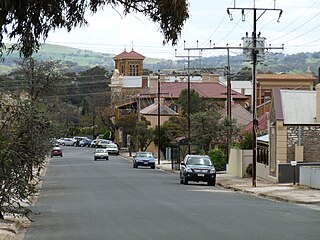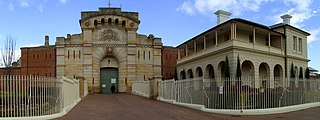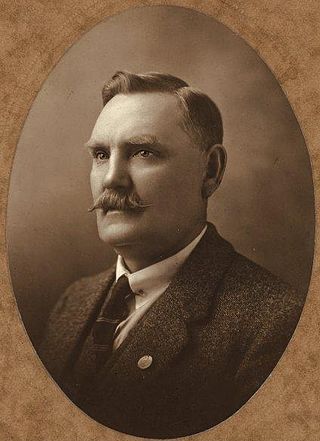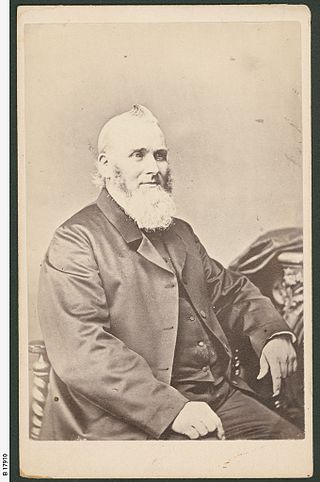
Kapunda is a town on the Light River near the Barossa Valley in South Australia. It was established after a discovery in 1842 of significant copper deposits. The population was 2,917 at the 2016 Australian census.

Burra is a pastoral centre and historic tourist town in the mid-north of South Australia. It lies east of the Clare Valley in the Bald Hills range, part of the northern Mount Lofty Ranges, and on Burra Creek. The town began as a single company mining township that, by 1851, was a set of townships collectively known as "The Burra". The Burra mines supplied 89% of South Australia's and 5% of the world's copper for 15 years, and the settlement has been credited with saving the economy of the struggling new colony of South Australia. The Burra Burra Copper Mine was established in 1848 mining the copper deposit discovered in 1845. Miners and townspeople migrated to Burra primarily from Cornwall, Wales, Scotland and Germany. The mine first closed in 1877, briefly opened again early in the 20th century and for a last time from 1970 to 1981.

Bathurst Correctional Centre, originally built as Bathurst Gaol in 1888, is a prison for men and women located in the city of Bathurst, New South Wales, Australia, and operated by the Department of Communities and Justice. Bathurst holds inmates sentenced under State or Australian criminal law, along with a small number of remand prisoners.

Maurice Collins was an Australian politician. He was a Country Party member of the Australian House of Representatives from 1928 to 1929, representing the electorate of Wakefield. He was reported to be "one of the best known personalities in the pastoral industry" in South Australia.
This is a list of members of the South Australian House of Assembly from 1915 to 1918, as elected at the 1915 state election:
South Australian Mining Association was a no-liability company which established several mines in South Australia, notably the "Grey Wheal", or north mine at Burra, which made a fortune for its promoters, the "Snobs", while the adjacent southern claim, by the Princess Royal Company ("Nobs") proved worthless.

Gladstone Gaol is a historic former prison in Gladstone, South Australia. It is listed on the South Australian Heritage Register.

The District Council of Belalie was a local government area in South Australia. It was proclaimed on 11 November 1875, and initially comprised most of the cadastral Hundred of Belalie, including its central town of Jamestown. Jamestown itself had originally been planned to be named Belalie when surveyed; while the town had been renamed, the Belalie name was retained for the council. It was divided into five wards at its inception with one councillor each, the first councillors for each being appointed by proclamation. The South-East and South-West wards had been replaced by the Yarcowie and Yongala wards by 1893.

Rev. James Maughan was a Methodist minister in Adelaide, South Australia. His name was commemorated in the Maughan Church, Franklin Street, which has since been demolished.
The District Council of Apoinga was a local government area in South Australia from 1873 to 1932.
James Pollitt was an Anglican missionary to South America and pioneering minister in South Australia.
The Telegraph was a newspaper in Adelaide, South Australia, founded in 1862, and merged with The Express to become The Express and Telegraph, published from 1867 to 1922.
The District Council of English was a local government area in South Australia from 1878 to 1932.
The Corporate Town of Burra was a local government area in South Australia from 1876 to 1969.
The District Council of Hanson was a local government area in South Australia from 1878 to 1935.
The District Council of Burra was a local government area in South Australia from 1872 to 1935.
Gum Creek is a rural locality in the Mid North region of South Australia, situated in the Regional Council of Goyder. It was established in August 2000, when boundaries were formalised for the "long established local name". It is named for the Gum Creek pastoral property, which originally extended from Farrell Flat to Mount Bryan, with the homestead being located in the Gum Creek locality. The property was owned by a number of notable figures, with Sir John Duncan succeeding Sir Walter Hughes as owner.
Willalo is a rural locality in the Mid North region of South Australia, situated in the Regional Council of Goyder. It was established in August 2000, when boundaries were formalised for the "long established local name". It was also known in its early days as North Booboorowie.
James Lyall was a Presbyterian minister in the early days of Adelaide, South Australia.
The Cheer-Up Society was a South Australian patriotic organisation founded during The Great War, whose aims were provision of creature comforts for soldiers in South Australia. Much of their activity was centred on the Cheer-up Hut, which they built behind the Adelaide railway station, and almost entirely staffed and organised by volunteers.
It is sufficient to know that we are all doing something to give pleasure and comfort to the brave soldiers who are going from Australia to fight for King and Empire; and that we hope to receive them on their return in this Cheer-up Hut of theirs – for it belongs to the soldiers and not to the members of the Cheer-up Society – where they will enjoy the comforts and rest of home. Nothing we can do is too good for these heroic soldiers of ours. The sphere of work of the society is kept within definite and specific limits, which do not overlap in the slightest the splendid patriotic work which is being carried out successfully by the S.A. Soldiers' Fund, the Red Cross, the Wattle Day League, the Y.M.C.A., the S.O.S., the Belgian Fund, and other like organizations. The desire of the members of the Cheer-up Society is to co-operate in the most amicable manner with all such societies.







